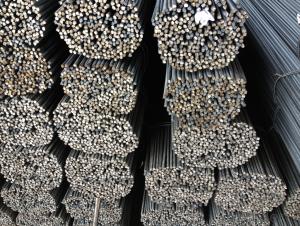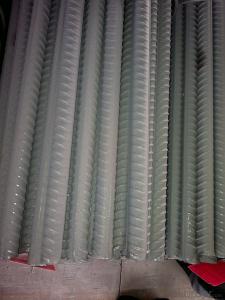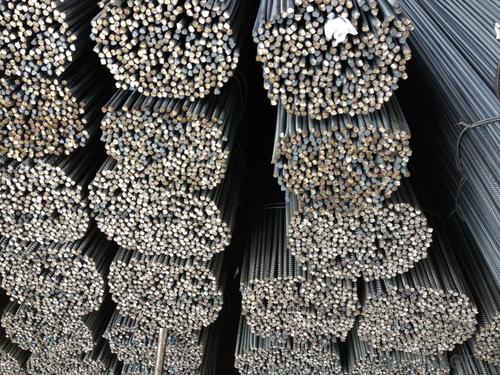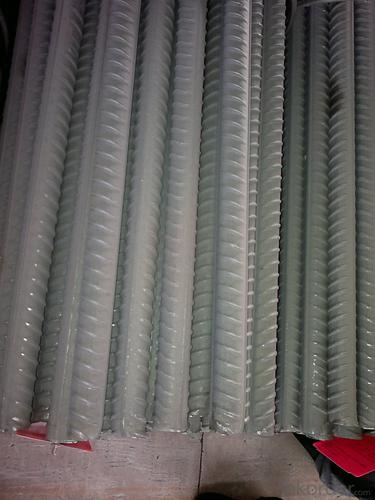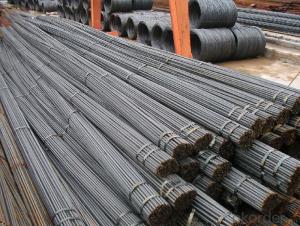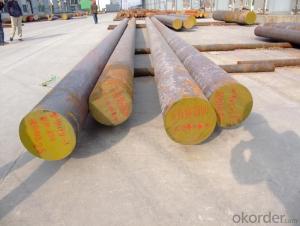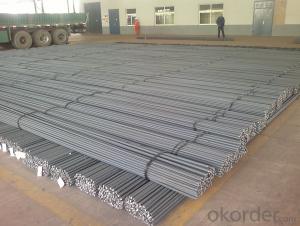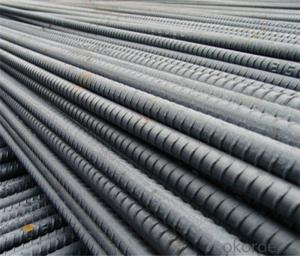Deformed Steel Bar, Iron Rods Bar for Construction/Concrete
- Loading Port:
- China main port
- Payment Terms:
- TT or LC
- Min Order Qty:
- 100 m.t.
- Supply Capability:
- 100000 m.t./month
OKorder Service Pledge
OKorder Financial Service
You Might Also Like
Product Description:
OKorder is offering Deformed Steel Bar, Iron Rods Bar for Construction/Concrete at great prices with worldwide shipping. Our supplier is a world-class manufacturer of steel, with our products utilized the world over. OKorder annually supplies products to African, South American and Asian markets. We provide quotations within 24 hours of receiving an inquiry and guarantee competitive prices.
Product Applications:
Deformed Steel Bar, Iron Rods Bar for Construction/Concrete are ideal for structural applications and are widely used in the construction of buildings and bridges, and the manufacturing, petrochemical, and transportation industries.
Product Advantages:
OKorder's Deformed Steel Bar, Iron Rods Bar for Construction/Concrete are durable, strong, and wide variety of sizes.
Main Product Features:
· Premium quality
· Prompt delivery & seaworthy packing (30 days after receiving deposit)
· Can be recycled and reused
· Mill test certification
· Professional Service
· Competitive pricing
Product Specifications:
Manufacture: Hot rolled
Grade: HRB335,HRB400,HRB500
Certificates: ISO, SGS, BV, CIQ
Length: 6m – 12m, as per customer request
Packaging: Export packing, nude packing, bundled
| DEFORMED BAR | |
| SIZE d(mm) | theoretical kg/m |
| 6 | 0.222 |
| 8 | 0.395 |
| 10 | 0.617 |
| 12 | 0.888 |
| 14 | 1.21 |
| 16 | 1.58 |
| 18 | 2 |
| 20 | 2.47 |
| 22 | 2.98 |
| 25 | 3.85 |
| 28 | 4.83 |
| 32 | 6.31 |
FAQ:
Q1: Why buy Materials & Equipment from OKorder.com?
A1: All products offered byOKorder.com are carefully selected from China's most reliable manufacturing enterprises. Through its ISO certifications, OKorder.com adheres to the highest standards and a commitment to supply chain safety and customer satisfaction.
Q2: How do we guarantee the quality of our products?
A2: We have established an advanced quality management system which conducts strict quality tests at every step, from raw materials to the final product. At the same time, we provide extensive follow-up service assurances as required.
Q3: How soon can we receive the product after purchase?
A3: Within three days of placing an order, we will arrange production. The normal sizes with the normal grade can be produced within one month. The specific shipping date is dependent upon international and government factors, the delivery to international main port about 45-60days.
Images:
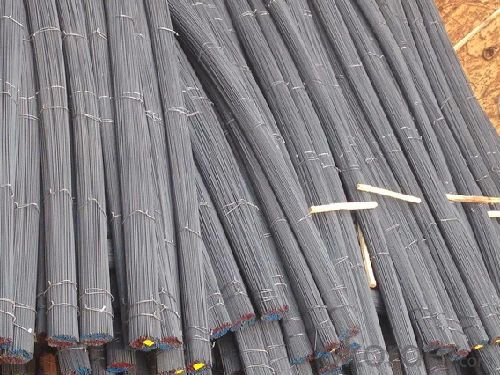
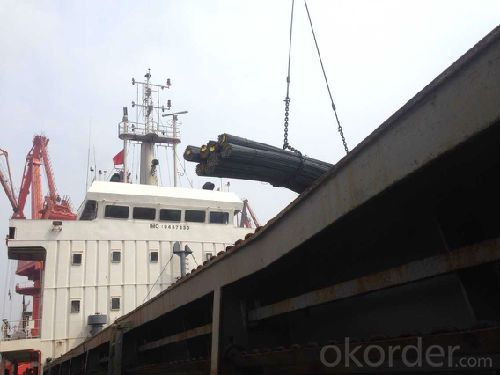
- Q: What are the guidelines for installing steel rebars in concrete columns?
- The guidelines for installing steel rebars in concrete columns involve several important considerations to ensure the structural integrity and durability of the columns. 1. Reinforcement design: The first step is to have a proper reinforcement design that specifies the size, length, and spacing of the rebars. This design should be prepared by a qualified engineer or consultant, taking into account the column's load-bearing requirements and the structural design standards. 2. Rebar preparation: Before installation, the steel rebars should be thoroughly cleaned to remove any rust, oil, or other contaminants that may hinder the bond between the rebar and the concrete. Additionally, the ends of the rebars should be properly cut and bent as specified in the reinforcement design. 3. Placement: The rebars should be placed accurately as per the reinforcement design. They should be positioned in the center of the column and secured to maintain the required spacing and alignment. The rebars should not touch the formwork or be placed too close to the edges of the column. 4. Splicing: When the height of the column exceeds the length of the rebar, splicing is necessary. Rebar splicing should be done according to the approved methods, such as lap splicing, mechanical couplers, or welded splices. The spliced rebars should have sufficient overlap length and provide a continuous load path. 5. Tying: Proper tying of the rebars is crucial to maintain their position during the concrete pouring. The rebars should be tied securely at the intersections using binding wire or other approved tying methods. The ties should be tight enough to prevent displacement but not too tight to damage the rebars. 6. Concrete pouring: Once the rebars are installed, the concrete is poured into the formwork, surrounding the rebars completely. Care should be taken to avoid segregation or honeycombing in the concrete, which can compromise the bond between the rebars and the concrete. 7. Concrete cover: The reinforcement design will specify the required concrete cover over the rebars. This cover protects the rebars from corrosion and provides fire resistance. It is crucial to maintain the specified concrete cover throughout the column's height and ensure it is not compromised during construction. 8. Quality control: Regular inspections and quality control measures should be implemented during the installation process. This includes checking the reinforcement alignment, spacing, and cover, as well as verifying the use of proper tying methods and splicing techniques. By following these guidelines, the installation of steel rebars in concrete columns can be carried out effectively, ensuring the structural strength and durability of the columns. It is essential to adhere to the local building codes and standards, as well as seek professional advice if needed, to ensure the proper installation of rebars in concrete columns.
- Q: How are steel rebars used in parking structures?
- Steel rebars are used in parking structures to reinforce the concrete and provide structural strength. They are typically embedded within the concrete to ensure that the structure can withstand heavy loads and resist any potential cracks or damages. The rebars help distribute the weight evenly, enhancing the overall stability and durability of the parking structure.
- Q: What are the advantages of using steel rebars over other reinforcement materials?
- There are several advantages of using steel rebars over other reinforcement materials. Firstly, steel rebars are highly durable and have a high tensile strength, which makes them capable of withstanding heavy loads and preventing structural failure. Additionally, steel rebars have excellent bonding properties with concrete, ensuring a strong and reliable bond between the two materials. Moreover, steel rebars are readily available and cost-effective compared to other reinforcement materials. Lastly, steel rebars can be easily fabricated and bent into various shapes, allowing for versatile and customized reinforcement solutions for different construction needs.
- Q: Are steel rebars suitable for reinforcement in airport runways?
- Yes, steel rebars are suitable for reinforcement in airport runways. They provide the necessary strength and durability to withstand heavy loads and repetitive aircraft traffic. Additionally, steel rebars offer excellent resistance to cracking and can effectively distribute the load, ensuring the longevity and safety of the runway.
- Q: Are there any specific codes and standards for steel rebars?
- Yes, there are specific codes and standards for steel rebars. The most widely used international standard for steel rebars is the ASTM A615/A615M Standard Specification for Deformed and Plain Carbon-Steel Bars for Concrete Reinforcement. Additionally, different countries may have their own national standards and codes for steel rebars, such as the British Standard BS 4449:2005 for steel rebars in the United Kingdom. These codes and standards ensure the quality, strength, and performance of steel rebars in construction and reinforce the safety of reinforced concrete structures.
- Q: Can steel rebars be used in structures with high levels of chloride or sulfate attack?
- No, steel rebars should not be used in structures with high levels of chloride or sulfate attack. Chloride attack occurs when chloride ions penetrate the concrete and react with the steel, causing corrosion. This can result in the degradation of the rebars and the overall structural integrity of the building. Similarly, sulfate attack occurs when sulfate ions react with the components of the concrete, leading to the formation of expansive compounds that cause cracking and deterioration. To prevent these types of attacks, alternative materials such as stainless steel rebars or corrosion-resistant alloys should be used in structures exposed to high levels of chloride or sulfate. These materials have a higher resistance to corrosion and can better withstand the aggressive chemical environment. Additionally, proper design and construction techniques, such as adequate concrete cover and the use of protective coatings, can also help mitigate the effects of chloride or sulfate attack. It is important to consult with structural engineers or corrosion specialists to determine the best approach for each specific project.
- Q: How do steel rebars affect the weight of a concrete structure?
- The weight of a concrete structure can be significantly impacted by steel rebars. These rebars, typically made of steel, reinforce the concrete and enhance its strength and durability. They are primarily placed in areas of concrete under tension, such as the bottom of beams or the middle of slabs. While the presence of steel rebars does add to the overall weight of the structure, it also allows for the use of less concrete. By adding reinforcement, the concrete can withstand higher loads and stresses, reducing the need for excessive amounts of concrete. As a result, the structure becomes lighter. Furthermore, steel rebars enable the design and construction of more slender and efficient structures. The increased strength provided by the rebars allows for longer spans and thinner sections, which reduces the dead load. This not only decreases the weight of the structure but also offers more flexibility in architectural and structural design. In addition, the weight of a concrete structure is a critical consideration, particularly in high-rise buildings or long-span structures. Excessive weight can strain the foundation and increase construction costs. By utilizing steel rebars, the weight of the concrete structure can be optimized without compromising its structural integrity. To sum up, steel rebars play a crucial role in reducing the weight of concrete structures. They enable the use of less concrete while maintaining the required strength, resulting in lighter and more efficient structures. The use of rebars also provides flexibility in design and reduces construction costs associated with excessive weight.
- Q: What is the process of epoxy-coating steel rebars?
- To achieve a durable and corrosion-resistant coating on steel rebars, several steps are involved in the process of epoxy-coating. Here is a general overview of the process: Firstly, the steel rebars undergo thorough surface preparation to eliminate any rust, oil, or other contaminants. This can be accomplished through techniques such as sandblasting or chemical cleaning. Once the rebars are cleaned, a primer is applied to enhance adhesion between the steel surface and the epoxy coating. Additionally, the primer provides an extra layer of protection against corrosion. After the primer has dried, the epoxy coating is applied to the rebars. This can be done using various methods, including spray application or immersing the rebars in an epoxy tank. Following the application of the epoxy coating, the rebars are left to cure. This controlled process allows the coating to harden and fully bond with the steel surface. The curing time varies depending on the specific epoxy and environmental conditions. Once the rebars have cured, a thorough inspection is conducted to ensure the uniform application of the epoxy coating and that it meets the required specifications. This inspection may involve visual checks, adhesion tests, and measurements of coating thickness. After passing inspection, the epoxy-coated steel rebars are packaged and stored in a controlled environment to protect them from damage or further contamination. It is important to note that the specific process may vary depending on factors such as the manufacturer, project requirements, and the type of epoxy coating used. Following industry standards and guidelines is crucial to ensure the quality and effectiveness of the epoxy-coated steel rebars.
- Q: Can steel rebars be used in the rehabilitation of existing structures?
- Yes, steel rebars can be used in the rehabilitation of existing structures. Steel rebars are commonly used for reinforcing existing structures to improve their strength and durability. By adding steel rebars, the structure can better withstand loads and stresses, thereby enhancing its overall structural integrity. Additionally, steel rebars can also help in preventing or mitigating the effects of deterioration, such as corrosion, which can prolong the lifespan of the rehabilitated structure.
- Q: What are the different types of steel rebars used in marine construction?
- The different types of steel rebars used in marine construction include epoxy-coated rebars, stainless steel rebars, and galvanized rebars. Epoxy-coated rebars are commonly used in marine environments due to their corrosion resistance properties. Stainless steel rebars are also used for their excellent corrosion resistance and strength. Galvanized rebars, which are coated with a layer of zinc, are another option for marine construction as they provide good protection against corrosion.
Send your message to us
Deformed Steel Bar, Iron Rods Bar for Construction/Concrete
- Loading Port:
- China main port
- Payment Terms:
- TT or LC
- Min Order Qty:
- 100 m.t.
- Supply Capability:
- 100000 m.t./month
OKorder Service Pledge
OKorder Financial Service
Similar products
Hot products
Hot Searches
Related keywords
